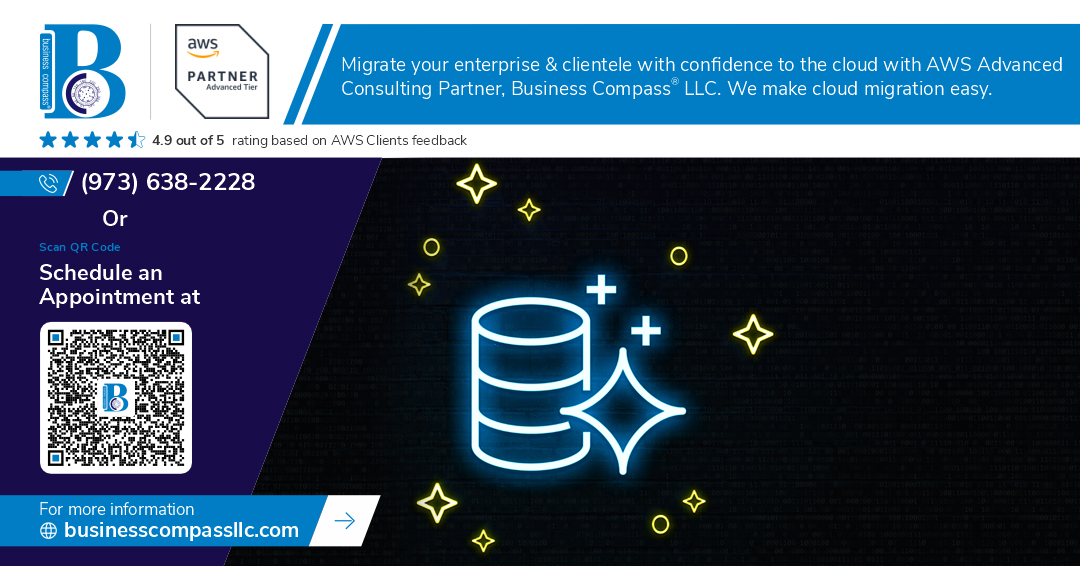🚀 The database landscape is evolving at warp speed, and Amazon Web Services (AWS) is at the forefront of this revolution. Are you ready to dive into the future of data management? From the robust Relational Database Service (RDS) to the lightning-fast DynamoDB, AWS is reshaping how we store, process, and analyze data.
But here’s the burning question: With so many options available, how do you choose the right database service for your needs? Whether you’re dealing with traditional relational data, need blazing-fast NoSQL performance, or require powerful analytics capabilities, AWS has a solution. However, navigating this complex ecosystem can be overwhelming.
In this post, we’ll embark on a journey through AWS’s database offerings, exploring the latest advancements in RDS, DynamoDB, Aurora, Redshift, and ElastiCache. We’ll uncover emerging trends and provide insights to help you make informed decisions about your data infrastructure. So, buckle up as we decode the future of databases in AWS and discover how these technologies can propel your business into the data-driven era. 💾🔮
Overview of AWS Database Services
Comparing RDS, DynamoDB, Aurora, Redshift, and ElastiCache
AWS offers a diverse range of database services to cater to various application needs. Let’s compare these services:
| Service | Type | Best For | Scalability | Performance |
|---|---|---|---|---|
| RDS | Relational | Traditional apps | Vertical | Good |
| DynamoDB | NoSQL | High-traffic apps | Horizontal | Excellent |
| Aurora | Relational | Cloud-native apps | Both | High |
| Redshift | Data Warehouse | Analytics | Massive | Optimized for queries |
| ElastiCache | In-memory | Caching | Horizontal | Ultra-fast |
Key features and use cases for each service
-
RDS (Relational Database Service):
- Supports multiple engines (MySQL, PostgreSQL, Oracle, SQL Server)
- Automated backups and patching
- Use case: E-commerce platforms, content management systems
-
DynamoDB:
- Fully managed NoSQL database
- Single-digit millisecond latency
- Use case: Gaming leaderboards, real-time bidding platforms
-
Aurora:
- MySQL and PostgreSQL compatible
- Auto-scaling storage
- Use case: SaaS applications, microservices architectures
Evolution of AWS database offerings
AWS has continuously evolved its database services to meet growing demands:
- Started with RDS for traditional relational databases
- Introduced DynamoDB to address NoSQL needs
- Developed Aurora as a cloud-native relational database
- Added Redshift for data warehousing and analytics
- Launched ElastiCache to enhance application performance
This evolution reflects AWS’s commitment to providing comprehensive database solutions for diverse workloads in the cloud era.
Relational Database Service (RDS) Advancements
Multi-AZ deployments and read replicas
RDS Multi-AZ deployments provide enhanced availability and durability for your databases. This feature automatically creates a synchronized standby replica in a different Availability Zone, ensuring seamless failover in case of infrastructure failures.
Key benefits of Multi-AZ deployments:
- High availability
- Automatic failover
- Increased durability
- Simplified maintenance
Read replicas, on the other hand, improve read performance by offloading read queries from the primary database. They can be created across multiple Availability Zones or even regions.
| Feature | Multi-AZ | Read Replicas |
|---|---|---|
| Purpose | High availability | Read scaling |
| Synchronization | Synchronous | Asynchronous |
| Failover | Automatic | Manual |
| Cross-region | No | Yes |
Performance insights and enhanced monitoring
RDS Performance Insights provides a powerful tool for monitoring and optimizing database performance. It offers real-time and historical views of database load, helping you identify performance bottlenecks quickly.
Key features:
- Dashboard with load chart
- Top SQL queries
- Wait event analysis
- Resource metrics
Enhanced Monitoring complements Performance Insights by providing detailed system-level metrics, such as CPU, memory, and I/O utilization.
Automated backups and point-in-time recovery
RDS automated backups ensure data protection and enable point-in-time recovery. This feature automatically backs up your database and transaction logs, allowing you to restore your database to any point within the retention period.
Benefits of automated backups:
- Data protection
- Flexible recovery options
- Customizable retention periods
- Minimal performance impact
With these advancements, RDS continues to evolve, offering robust solutions for relational database management in the cloud. Next, we’ll explore how DynamoDB is leading the NoSQL revolution in AWS.
DynamoDB: Leading the NoSQL Revolution
Global tables for multi-region replication
DynamoDB’s global tables feature revolutionizes multi-region data replication, enabling seamless global distribution of your NoSQL data. This feature allows you to maintain multiple active replicas of your tables across different AWS regions, ensuring low-latency access for your global user base.
Key benefits of global tables include:
- Improved availability
- Disaster recovery
- Reduced latency for global users
- Simplified compliance with data sovereignty requirements
| Feature | Benefit |
|---|---|
| Active-active replication | Enables read/write operations in multiple regions |
| Automatic conflict resolution | Ensures data consistency across regions |
| Sub-second replication | Minimizes data lag between regions |
On-demand capacity for unpredictable workloads
DynamoDB’s on-demand capacity mode offers a flexible pricing option for applications with unpredictable workloads. This feature automatically scales up or down based on your application’s needs, eliminating the need for capacity planning.
Benefits of on-demand capacity:
- Pay-per-request pricing
- Automatic scaling
- No minimum capacity
- Ideal for spiky, unpredictable workloads
DynamoDB Streams for real-time data processing
DynamoDB Streams enables real-time processing of data changes in your DynamoDB tables. This feature captures a time-ordered sequence of item-level modifications, allowing you to build powerful event-driven architectures.
Use cases for DynamoDB Streams:
- Real-time analytics
- Cross-region replication
- Triggering Lambda functions
- Maintaining cache coherency
DynamoDB Accelerator (DAX) for improved performance
DAX is a fully managed, in-memory cache for DynamoDB that significantly improves read performance. By implementing DAX, you can achieve microsecond latency for frequently accessed data, reducing the load on your DynamoDB tables.
Key advantages of DAX:
- Microsecond latency for cached reads
- Seamless integration with existing DynamoDB applications
- Fully managed service with no maintenance overhead
- Ideal for read-heavy workloads
With these advanced features, DynamoDB continues to lead the NoSQL revolution, offering unparalleled scalability, performance, and flexibility for modern cloud-native applications.
Aurora: The Next-Generation Relational Database
Serverless architecture for automatic scaling
Aurora’s serverless architecture revolutionizes database management by automatically scaling resources based on workload demands. This eliminates the need for manual capacity planning and provisioning, allowing developers to focus on application development rather than infrastructure management.
Key benefits of Aurora Serverless:
- Cost-efficiency: Pay only for actual usage
- Seamless scaling: Adapts to traffic spikes instantly
- Simplified operations: Automates administrative tasks
| Feature | Traditional RDS | Aurora Serverless |
|---|---|---|
| Scaling | Manual | Automatic |
| Capacity Planning | Required | Not required |
| Minimum Resources | Fixed | Scales to zero |
| Billing | Hourly | Per-second |
Multi-master capabilities for high availability
Aurora’s multi-master feature enhances database availability and fault tolerance by allowing multiple database instances to accept read and write operations simultaneously. This architecture eliminates single points of failure and enables seamless failover without downtime.
Benefits of multi-master:
- Increased write performance
- Improved application availability
- Simplified disaster recovery
Machine learning integration with Aurora ML
Aurora ML integrates machine learning capabilities directly into the database, enabling developers to leverage AI/ML models for advanced analytics and predictions without moving data out of the database.
Use cases for Aurora ML:
- Fraud detection in financial transactions
- Personalized product recommendations
- Predictive maintenance in IoT applications
By combining serverless architecture, multi-master capabilities, and machine learning integration, Aurora positions itself as a cutting-edge relational database solution, ready to meet the evolving needs of modern applications. As we explore further, we’ll see how Redshift complements Aurora by addressing specific data warehousing and analytics requirements.
Redshift: Powering Data Warehousing and Analytics
Redshift Spectrum for querying exabytes of data
Redshift Spectrum revolutionizes data analysis by enabling queries on massive datasets stored in Amazon S3. This powerful feature allows organizations to:
- Query data directly in S3 without loading it into Redshift
- Scale to exabytes of data seamlessly
- Separate storage and compute resources for cost optimization
| Feature | Benefit |
|---|---|
| S3 Integration | Query data without ETL |
| Exabyte Scale | Handle massive datasets |
| Cost Efficiency | Pay only for queries run |
Concurrency scaling for handling peak loads
Redshift’s concurrency scaling feature addresses the challenge of managing high-demand periods:
- Automatically adds cluster capacity during peak times
- Scales down when demand decreases
- Ensures consistent query performance under varying loads
This capability is crucial for businesses with fluctuating analytical needs, providing a smooth user experience without over-provisioning resources.
Federated query for cross-database analysis
Federated query enhances Redshift’s analytical capabilities by enabling:
- Querying data across multiple databases and data warehouses
- Seamless integration with RDS PostgreSQL and Aurora PostgreSQL
- Real-time data analysis without complex ETL processes
This feature breaks down data silos, allowing for comprehensive insights across an organization’s entire data ecosystem. As we explore the next section, we’ll see how ElastiCache complements these powerful data warehousing capabilities by enhancing application performance.
ElastiCache: Enhancing Application Performance
Redis vs. Memcached engine options
ElastiCache offers two powerful in-memory data store engines: Redis and Memcached. Each has its strengths, catering to different use cases and application requirements.
| Feature | Redis | Memcached |
|---|---|---|
| Data types | Complex (strings, lists, sets, hashes) | Simple (key-value pairs) |
| Persistence | Supports data persistence | No data persistence |
| Replication | Multi-AZ with automatic failover | No built-in replication |
| Scalability | Vertical and horizontal | Horizontal only |
| Use cases | Advanced caching, real-time analytics | Simple caching, session storage |
Redis excels in scenarios requiring advanced data structures and persistence, while Memcached shines in simple, high-performance caching scenarios.
Auto-scaling for dynamic workloads
ElastiCache now offers auto-scaling capabilities, allowing your cache to dynamically adjust to changing workloads. This feature ensures:
- Optimal performance during traffic spikes
- Cost-efficiency during low-demand periods
- Automatic node addition or removal based on predefined metrics
Global datastore for multi-region replication
For applications serving a global audience, ElastiCache’s global datastore feature enables:
- Low-latency read access across multiple regions
- Disaster recovery with fast failover between regions
- Compliance with data sovereignty requirements
This multi-region replication capability enhances application performance and reliability on a global scale.
Now that we’ve explored ElastiCache’s performance-enhancing features, let’s examine the emerging trends shaping the future of AWS database technologies.
Emerging Trends in AWS Database Technologies
Serverless database options
As AWS continues to innovate, serverless database options are becoming increasingly popular. These solutions offer automatic scaling, pay-per-use pricing, and reduced operational overhead. Amazon Aurora Serverless and DynamoDB On-Demand are leading the charge in this space.
| Feature | Aurora Serverless | DynamoDB On-Demand |
|---|---|---|
| Database Type | Relational | NoSQL |
| Scaling | Automatic | Automatic |
| Pricing | Pay-per-second | Pay-per-request |
| Use Cases | Variable workloads | Unpredictable traffic |
Integration with AI and machine learning
AWS is leveraging the power of AI and machine learning to enhance database performance and functionality. Some key integrations include:
- Amazon Aurora ML: Enables developers to add ML-based predictions to applications
- Amazon Redshift ML: Allows data analysts to create, train, and deploy ML models using SQL
- DynamoDB with Amazon SageMaker: Facilitates building ML models on DynamoDB data
Enhanced security features and compliance
Security remains a top priority for AWS database services. Recent advancements include:
- Advanced encryption options
- Fine-grained access controls
- Automated compliance controls for various regulations (e.g., GDPR, HIPAA)
- Integration with AWS security services like AWS KMS and AWS IAM
Improved cost optimization tools
AWS is introducing new tools to help users optimize database costs:
- Intelligent tiering for data storage
- Automated resource scaling based on workload
- Cost explorer enhancements for better visibility into database expenses
These emerging trends are shaping the future of AWS database technologies, offering users more flexibility, security, and cost-effectiveness. As we move forward, we’ll explore how to choose the right AWS database service for your specific needs.
Choosing the Right AWS Database Service
Performance considerations
When selecting an AWS database service, performance is a critical factor. Different services excel in various scenarios:
- RDS: Ideal for traditional relational workloads
- DynamoDB: Excels in high-throughput, low-latency applications
- Aurora: Offers superior performance for MySQL and PostgreSQL workloads
- Redshift: Optimized for complex analytical queries on large datasets
- ElastiCache: Provides sub-millisecond latency for caching scenarios
| Database Service | Performance Strength |
|---|---|
| RDS | Consistent OLTP performance |
| DynamoDB | High-throughput, low-latency |
| Aurora | 5x faster than standard MySQL |
| Redshift | Fast querying of petabyte-scale data |
| ElastiCache | Sub-millisecond data retrieval |
Scalability requirements
Scalability is crucial for growing applications. Consider these points:
- RDS: Vertical scaling with some horizontal read scaling
- DynamoDB: Seamless horizontal scaling
- Aurora: Auto-scaling with up to 15 read replicas
- Redshift: Elastic resize for quick scaling
- ElastiCache: Horizontal scaling with cluster mode
Data consistency and durability needs
Different AWS database services offer varying levels of consistency and durability:
- RDS & Aurora: Strong consistency with multi-AZ deployments
- DynamoDB: Configurable consistency levels
- Redshift: Eventually consistent with periodic snapshots
- ElastiCache: In-memory data with optional persistence
Cost-effectiveness analysis
Evaluate the cost-effectiveness based on your specific use case:
- RDS: Pay for instance hours, storage, and I/O
- DynamoDB: Pay for read/write capacity or on-demand pricing
- Aurora: Similar to RDS but with better performance per dollar
- Redshift: Pay for compute node hours and storage
- ElastiCache: Pay for node hours and data transfer
Consider factors like data volume, access patterns, and required performance to make an informed decision. Each service offers unique pricing models that may be more cost-effective depending on your specific workload and scaling needs.
AWS continues to revolutionize the database landscape with its diverse and innovative services. From RDS’s advancements in relational databases to DynamoDB’s leadership in NoSQL, and Aurora’s next-generation capabilities, AWS offers solutions for every data need. Redshift powers data warehousing and analytics, while ElastiCache enhances application performance. As emerging trends shape the future of database technologies, AWS remains at the forefront of innovation.
Choosing the right AWS database service is crucial for optimizing your applications and business processes. By understanding the strengths and use cases of each service, you can make informed decisions that align with your specific requirements. As AWS continues to evolve its database offerings, staying informed and leveraging these powerful tools will be key to maintaining a competitive edge in the data-driven world of tomorrow.




















